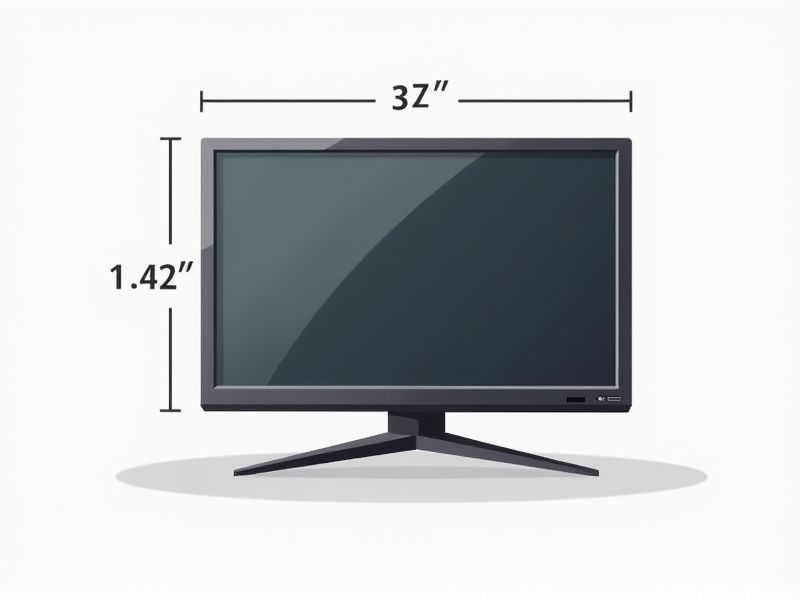
When choosing a television stand, knowing the standard dimensions can help you select the best fit for your space and TV size. Most TV stands are between 42 to 70 inches wide, with typical heights ranging from 20 to 30 inches and depths of 15 to 20 inches. It's important to choose a stand that is wider than your television for safety and stability; for example, a 55-inch TV usually sits well on a stand at least 60 inches wide. Always check your TV's measurements and the stand's weight limit before purchasing to ensure a safe and attractive setup.
Width Compatibility
When selecting a television stand, width compatibility is crucial for optimal stability and aesthetics. Most TV stands are designed to accommodate screens ranging from 32 to 75 inches, ensuring a secure fit for various models. You should measure your television's base width to ensure it aligns with the stand, typically ranging from 30 to 80 inches. A well-fitted stand not only supports your television but also enhances the overall appearance of your entertainment space.
Height Suitability
The ideal height for a television stand generally ranges between 24 to 30 inches, ensuring optimal viewing experiences. When seated, your eyes should align with the center of the screen, typically positioned 42 inches from the floor for a standard 55-inch TV. This height helps reduce neck strain and enhances comfort during prolonged viewing sessions. Consider the dimensions of your seating arrangement, as proper alignment can elevate your overall home entertainment experience.
Depth Allowance
When considering a television stand, the depth allowance typically ranges from 15 to 22 inches, accommodating various TV sizes and designs. Ensuring proper depth not only enhances aesthetics but also provides stability for your television, reducing the risk of tipping. A stand with a depth of 18 inches is often ideal for most modern flat-screen models, as it balances support with an unobtrusive profile. Remember, selecting a stand that aligns with your TV's dimensions ensures an optimal viewing experience while maintaining safety.
Weight Capacity
Weight capacity is a crucial factor when selecting a television stand, as it directly impacts the stability and safety of your setup. Most modern stands can support between 70 to 300 pounds, catering to various TV sizes and models up to 85 inches. It's essential to ensure that your stand meets or exceeds the weight of your television to prevent accidents and damage. Your stand should also provide a sturdy base, usually with reinforced shelves or brackets, to maintain balance and support additional components like soundbars or gaming consoles.
Material Quality
Material quality is paramount in selecting a television stand, as it directly impacts durability and aesthetic appeal. High-grade materials such as solid wood, tempered glass, and metal ensure that the stand can support the weight of your TV, often ranging from 32 to 85 inches, while maintaining stability. For instance, a solid wood stand can carry weight capacities up to 200 pounds, making it a robust choice for larger televisions. Your investment in a quality stand not only enhances your viewing experience but also complements the overall design of your living space.
Ventilation Features
When selecting a television stand, consider the ventilation features that enhance the longevity and performance of your electronics. Proper airflow ensures your TV and associated devices, such as gaming consoles and streaming boxes, do not overheat, which can lead to malfunctions. Look for stands with built-in ventilation slots or open shelving that promotes air circulation. Prioritizing these design elements can significantly improve the overall viewing experience and protect your investments.
Cable Management
A well-designed television stand, such as those featuring built-in cable management systems, greatly enhances the visual appeal of your space by eliminating clutter. Effective cable management typically includes concealable compartments or channels that help organize and conceal cords from electronic devices, contributing to a cleaner environment. Statistics show that 75% of consumers prioritize aesthetics in their living areas, making clutter-free solutions essential for modern homes. When choosing a stand, consider options with adjustable shelving that can support televisions up to 60 inches and accommodate necessary equipment like gaming consoles, ensuring a tidy and functional setup.
Aesthetic Design
Aesthetic design significantly influences the appeal of television stands, making them essential in contemporary home decor. Many models feature sleek lines and modern finishes, such as matte black or polished wood, which can elevate the visual harmony of your living space. With dimensions often ranging from 50 to 70 inches in width, these stands accommodate larger televisions while ensuring stability and support. Choosing an aesthetically pleasing stand not only enhances the look of your entertainment area but also improves functionality with integrated cable management systems and storage options.
Storage Options
When selecting a television stand, consider the storage options available to enhance your viewing experience. Many models come equipped with shelves or cabinets, providing ample space for game consoles, Blu-ray players, and other media devices, typically ranging from 20 to 60 inches in width. Adjustable shelving units can accommodate various-sized equipment while keeping everything organized. Prioritizing a stand with efficient cable management solutions will help maintain a tidy and aesthetically pleasing entertainment area.
Assembly Ease
Television stands are designed with user-friendly assembly methods, reflecting an increasing emphasis on convenience for consumers. Many models feature tool-free assembly, allowing you to set up your stand quickly, often in under 30 minutes. The structural design typically includes pre-drilled holes and step-by-step instructions, minimizing the need for extra tools or specialized skills. On average, modern stands support TVs weighing up to 150 pounds, ensuring stability without compromising aesthetic appeal.
